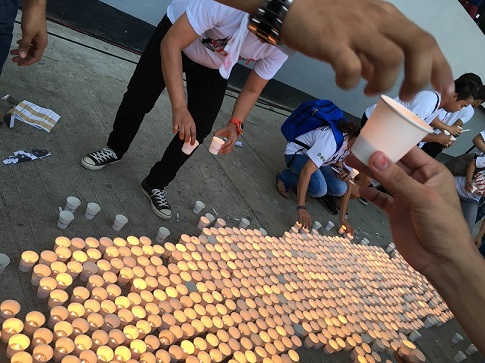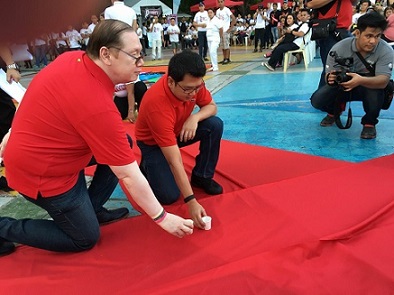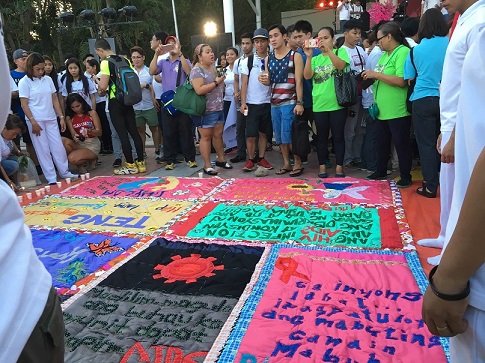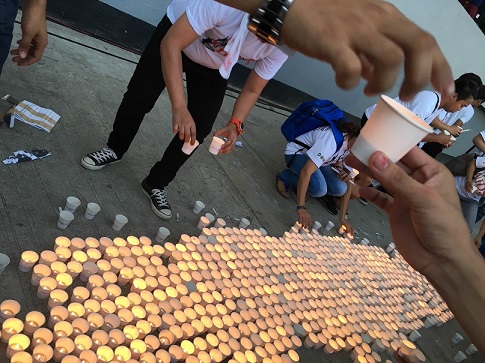
By DIANA G. MENDOZA
THE Philippines became the first country in the world to stage the “AIDS Hour” as it joined the 33rd International AIDS Candlelight Memorial last night in lighting a candle from 6 to 7 pm as an act of solidarity in remembering those who died of AIDS.
Amidst the unabated rise of its HIV epidemic, the Philippines is also looking at expanding its efforts to include all the other segments of society and not just to the medical and health sectors that have been at the forefront of handling HIV infections, treatment, care and support.
Health Secretary Janette Loreto-Garin said, “We can stop HIV transmission only through a collective societal effort, beginning with widespread awareness about HIV and the necessary preventive behaviors and measures.” In a statement released by the Department of Health on the eve of the International AIDS Candlelight Memorial (IACM), Garin said, “HIV is just a virus. We cannot allow it to destroy the lives of our fellow Filipinos.”

In joining the observance of the IACM, the DOH collaborated with the Quezon City government that led the central event at the Liwasang Aurora at the Quezon City Memorial Circle starting at 3 pm with a parade around the circle, unveiling of the AIDS quilt and the red ribbon ceremony where lighted candles are placed on a huge red ribbon on the ground.
The AIDS quilt is an advocacy tool that is a hand sewn art panel of cloth patches, trimmings or illustrations symbolizing the names or images representing the persons who have passed away from AIDS. Organizations of Filipinos living with HIV, along with family members and loved ones of whose who died of AIDS, have rendered and kept their own quilts since the early 1990s that are unwrapped for AIDS candlelight events.
Other local governments and civil society organizations usually hold their own memorials simultaneously, characterized by lighting of candles.
This year, the launch of the AIDS Hour will also be the start of naming the global event as the Philippine AIDS Candlelight Memorial (PACM) to encourage an annual nationwide observance and solidarity that also coincides with the world event.
“The launch of the first ever AIDS Hour in the world is a concrete example of the Philippines doing our part in the global effort against HIV and AIDS,” said Garin. “We need to raise awareness because many people living with HIV do not know that health services are available to them while others are afraid to consult, or are socially stigmatized for being HIV-positive.” She said she hoped the AIDS Hour movement will spread not just in the Philippines but globally.
With the annual PACM and AIDS Hour, the DOH will select a host city to lead the awareness campaign about HIV. The host city will light or project a candle on a local landmark, which will be done by Quezon City as last night’s inaugural city for the AIDS Hour.

The DOH said the Filipino community in New York, USA will also conduct an AIDS Hour this month. “As we join the rest of the world in this memorial, let us remember that every candle we light represent our struggle to overcome HIV and AIDS,” said Garin.
The candlelight memorial started in 1983 in the gay community in San Francisco in the United States when four young men who were on the verge of dying from AIDS decided to put a “face to the disease” by coordinating a small vigil behind a banner reading “Fighting For Our Lives.” They also initiated a march that was joined by thousands. This event that began a worldwide movement for almost 30 years now sought the support of civil society.
The health department’s latest update through the monthly HIV and AIDS Registry recorded a total of 1,675 Filipinos who have died from AIDS complications and a total of 32,647 cases of HIV from 1984 to March 2016. A large 82% or 26,632 of this total were reported from January 2011 onward, the year when the DOH confirmed a huge spike in new infections that remained at an increasing trend until today. Currently, there 13,387 people living with HIV; 41% of whom are on anti-retroviral treatment that prolongs the life of an HIV-infected person.
More than half of all cases (16,697) belong to the 25-34 year age-group while 8,738 cases are youth aged 15-24 years. The predominant mode of transmission from 1984 to 2007 was heterosexual sex.
But the DOH said that after 2009, male-to-male sex became the predominant mode of transmission. In 2010, HIV transmission through sharing of infected needles started to increase. HIV is now spreading to female partners of infected male injecting drug users. Mother-to-child transmission also occurs during pregnancy, childbirth, and breastfeeding.

Dr. Julie Hall of the World Health Organization Western Pacific Regional Office said “the HIV epidemic in the Philippines is faster than any other country in the world including Africa.” From fairly low cases in previous years, the rise of new infections became way off that “when something is not done immediately, it can be catastrophic,” she said.
The WHO’s Global AIDS Report 2012 listed the Philippines as currently one of nine countries where more than 25% increase in new HIV infections were reported in 2011 than in 2001. The rapid spread of HIV infections is primarily due to the sharing of contaminated needles and syringes among people who inject drugs (PWID) and unprotected sex among men who have sex with men (MSM).
The DOH estimates that by 2022, there will be 133,000 persons with HIV who will need a total of P4 billion in health care expenditures through the Philippine Health Insurance Corp., which currently offers an annual P30,000 outpatient healthcare package to persons with HIV.
Health Secretary Garin said theDOH is continuously offering free and confidential HIV testing in social hygiene clinics run by local government units and in 22 HIV treatment hubs or hospitals nationwide.
In 2015, the department introduced the High Impact Breakthrough Strategies or Hi5 that aimed to reduce the number of new cases of HIV and AIDS by 40% by emphasizing an increase in the number of those who were made aware of their HIV status through counseling, screening and testing.
By knowing their HIV status through laboratory confirmation of HIV seropositivity or a positive test result also allows patients to avail of the PhilHealth Outpatient HIV/AIDS Treatment (OHAT) package.
The AIDS Hour event also asks everyone who use social media to upload on Facebook a photo of their AIDS Hour participation using the hashtag #AIDSHour2016 which can win prizes will be for the best photos.
Prior to last night’s AIDS Hour, Quezon City Mayor Herbert Bautista encouraged other local governments across the country, especially those with rising rates of HIV infections, to increase HIV awareness by financing activities that help people understand behavior change and prevention. “The gender and development budget can be used to finance and activate LGBT campaigns in the communities, and this will help greatly in educating the rest of the population as well,” he told the crowd of mostly local government, nongovernment, private sector and LGBT groups during the candlelight memorial.
Gundo Weiler, newly installed county representative for the Philippines of the WHO Western Pacific regional office, said many countries are witnessing lesser people mobilizing HIV awareness and prevention activities, “but the Philippines is contrary to the case.”
“In the Philippines, we see more people getting infected and dying. While we feel the pain and struggle, the key is to overcome these by staying together as a community,” he said. “Nobody should be dying anymore of AIDS if we commit to raise awareness, abide by prevention efforts and care for people affected by HIV.
tos.
